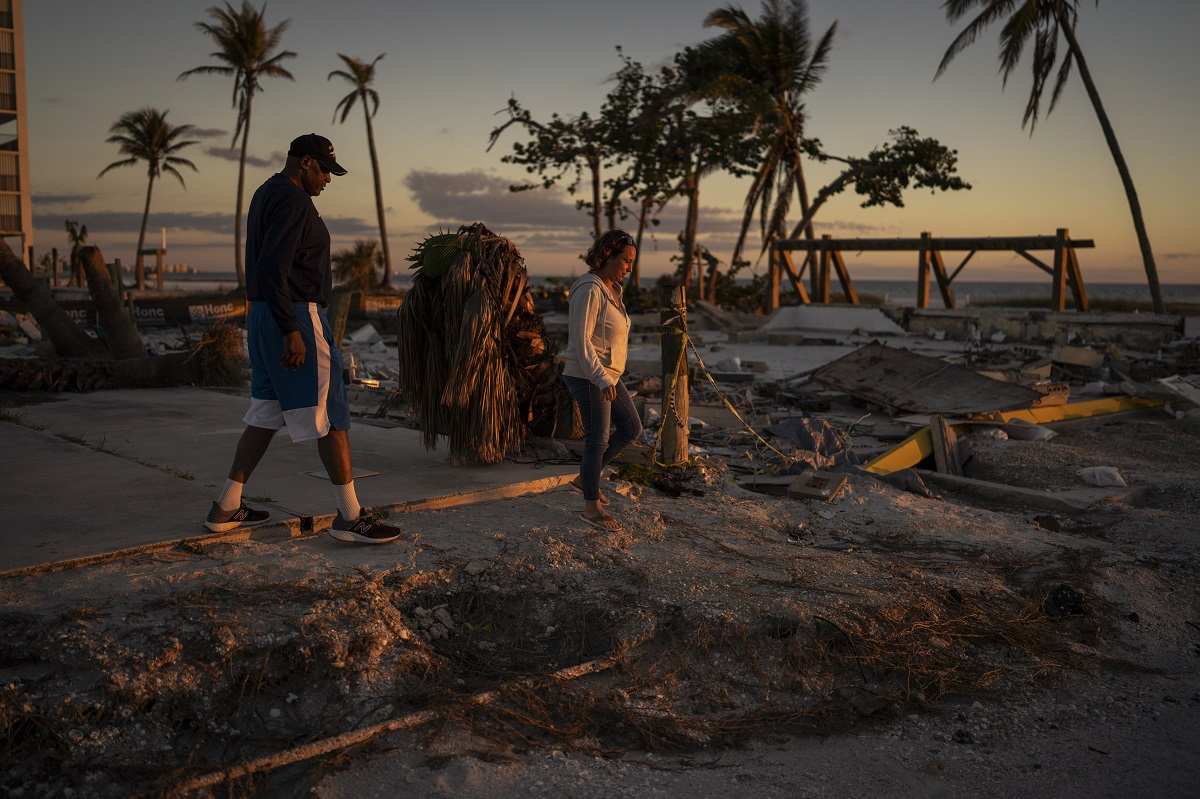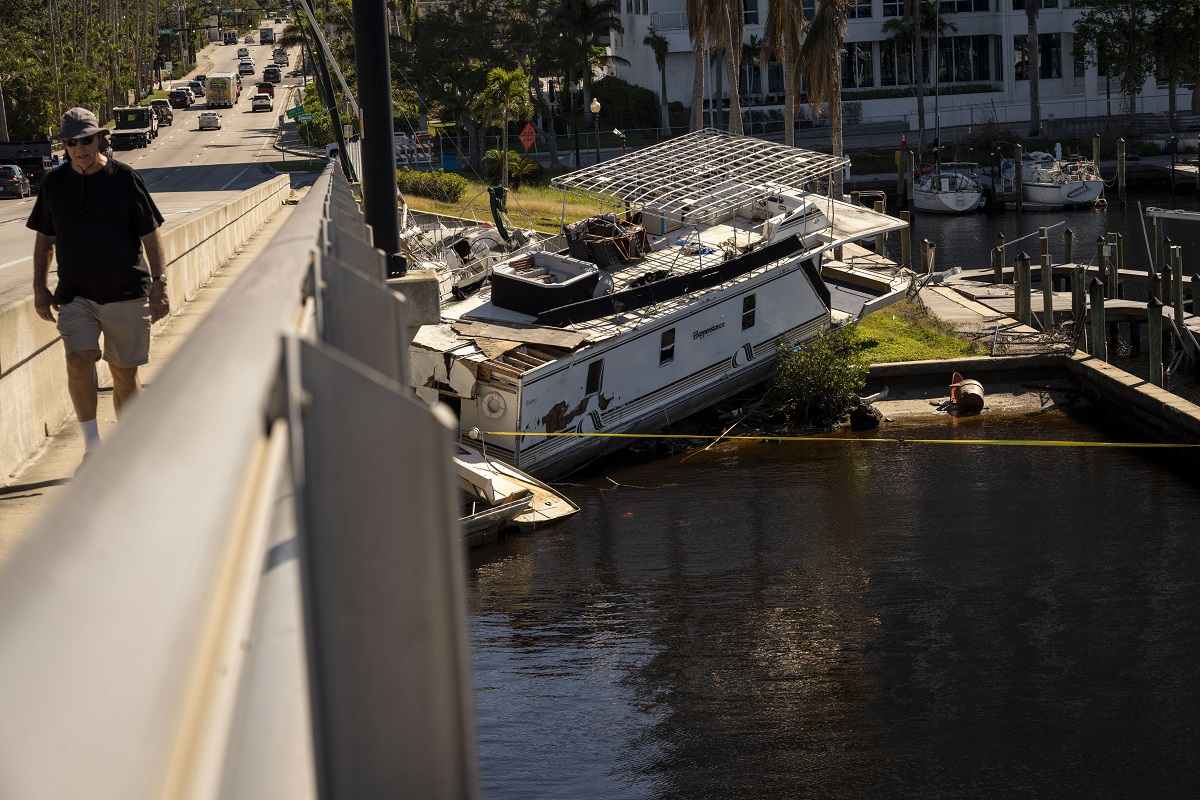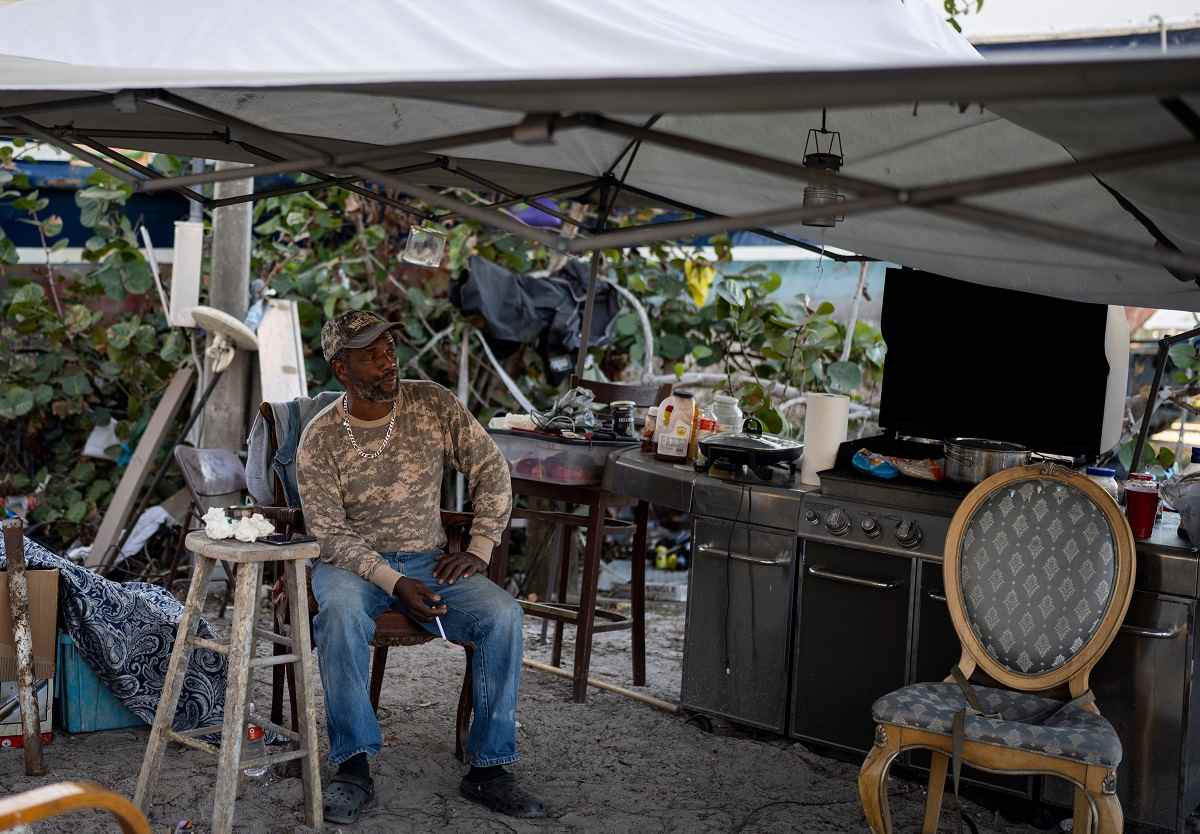
Gerald and Tara Boyd have been living out of their Dodge Nitro in Fort Myers Beach, Fla., since November in the wake of Hurricane Ian.
13:43 JST, February 4, 2023
FORT MYERS BEACH, Fla. – Some nights, Tara Boyd wishes she and her husband had just given up when the eight-foot storm surge from Hurricane Ian flooded their mobile home, forcing them to swim out into the storm. It would have been “easy to let go and just drift away,” she said. But they fought to survive. And they’ve been doing that ever since.
She hates to admit that living after Ian feels harder than living through its terror. She can’t help it, especially on the really hard, frustrating days spent at a Federal Emergency Management Agency recovery center obtaining no real answers about the progress of their aid applications and then getting into their black Dodge Nitro, which they’ve been living out of since November.
Boyd, 43, thinks about it when she watches her husband, Gerald Boyd, a veteran who was still recovering from a stroke when the storm hit in September, squeeze his long, hulking frame into the passenger seat at night to sleep. To deal with his cramping legs and aching back, the 53-year-old reminds himself that he has lived in tough conditions like this before, when he was in the Navy.
“This is more tragic than the hurricane itself,” Tara Boyd said.
Scores of other residents across southwest Florida are also living this way, in what disaster experts call the “storm after the storm”: the seemingly never-ending marathon that is navigating America’s slow, complex and dysfunctional disaster response.
The Category 4 hurricane killed nearly 150 people, according to the Florida Medical Examiners Commission, and caused $112.9 billion in damages, the third-costliest hurricane on record to ever hit the United States. Hundreds of people are still displaced more than four months later, cramming their partners, kids, and pets into cars, donated tents, motel rooms or, if they’re lucky, in trailers parked next to the debris that used to be their lives. Like the Boyds, some families are not sure where they will be sleeping next week, rotating between friends’ and family’s couches, or hotels when they can afford them.
Their routines of going to work, jogging around their neighborhood or spending happy hour at the storied dive bar are gone. Instead, they are stuck in a strange, warzone-like world where reliving trauma is routine, time feels suspended, and the only future they can focus on is just getting through one day.
And that one day is usually spent the same way, nearly 20 survivors, as well as a host of attorneys and policyholder advocates said: waiting hours on the phone or in line to speak with various agencies as they try to get temporary housing; rental assistance; insurance payouts; and funds to help them rebuild, get reimbursed for their hotels or buy groceries. By the end, they are told to get more paperwork or keep waiting.
So they do, because many, especially those without financial reserves and resources, don’t have much of a choice. The paths forward for Ian survivors are largely predicated on whether they will get recovery money from their insurance companies, the state, the federal government or a mix.
So far, these survivors say they haven’t received a dime. Others have spent a one-time $700 check FEMA allocates for “critical needs,” or small amounts they received weeks ago from the federal government or nonprofit groups.
“Going through the stress of this, having to jump through hoop after hoop, I used to cry every day. And now it’s gotten to the point where I don’t anymore,” Tara Boyd said. “I am just tired, and I want to give up.”
Her employer, a limousine company, is still out of commission. Before the storm, the couple had $18,000 in savings. After having to buy a new car after losing theirs in the surge waters and fronting hotel costs, they are down to $200.
“That part is scary,” said Gerald Boyd, who had to quit his job as a concrete mason foreman after his stroke. “But that doesn’t scare me as much as the fact that it’s not over yet.”
– – –

Damaged boats sit next to a bridge in Fort Myers, Fla., on Jan. 12. Months after Hurricane Ian laid waste to communities in the area, volunteers and officials are still finding bodies in sunken sailboats and tangled mangroves.
Trying to regain a sense of normalcy
As climate change has made disasters more destructive and costly, this liminal state has become the perpetual reality for many communities that are trying to fully recover. Many never truly do. As time passes, more vulnerable populations are falling further between the gaping cracks.
Disaster experts and response organizations say that it is taking longer for communities to get back on their feet largely because the scale and tremendous cost of recovery overwhelm local and state governments. Federal resources can get delayed or strained because of how many major disasters are now happening as the costs of living and building supplies have skyrocketed.
Rebounding from Ian could take a decade, disaster experts say, and one of the toughest hurdles is housing. The storm wiped out older, paid-off and mobile homes at a time when the state was already experiencing an extreme shortage of affordable options.
The large mobile-home community where the Boyds lived still does not have electricity or water; neither does its neighboring park, affecting more than 2,500 households. Blue tarps dot almost every other roof from Fort Myers Beach – which largely looked like a colossal junk yard in January – to Naples. Large boats still sit askew in marshes and on top of buildings.
Living in such destruction is only part of this new, nightmarish reality. Volunteers and officials are still finding bodies in sunken sailboats and tangled mangroves. Residents talk about the dead while checking out at the grocery store and trade survival stories over lunch around plastic tables and outdoor grills that were once their beloved beachfront restaurants. Meanwhile, small groups of tourists walk by carrying beach towels and drinks, drawn by Lee County’s promise of “bright spots” among the devastation.
To cope and survive mentally, the Boyds and other residents try to do what small things they can each day to regain any sense of normalcy. They sweep the dusty mats outside their tents; weed out dead flowers in front of their tarp-covered, leaking mobile homes; position rugs and lawn chairs in the dirt outside donated trailers so they can watch the sunset on a patio like they used to.
In the mornings, after folding up their blankets, repacking their spotless car and finding breakfast, the Boyds drive to the library, now a disaster recovery and resource center. They see the same survivors, sit in the same lines, approach the same aid tables, hoping for a different answer. But it’s usually the same: wait.
“It’s insanity, doing the same thing but waiting for a different result,” Gerald Boyd said. “Resigning to the fact that is not going to change is a whole different burden. I wholeheartedly believe that it will not change, because that is what I have seen thus far.”
– – –
Navigating the disaster recovery bureaucracy
While people largely look to FEMA, relatively small agency, for the bulk of the help, state and local municipalities are technically in charge of recovery. FEMA says its primary objective is to provide assistance for short-term, temporary housing and help reimburse for public assistance and clean up. The Small Business Administration and Department of Housing and Urban Development are also responsible for doling out money.
Florida does not have a dedicated recovery fund for Ian survivors, further highlighting the conundrum of who is responsible for helping people and how. Unite Florida, the state’s disaster response initiative, is available only to those FEMA denied. The initiative said that it does not distribute financial assistance because “that is a mechanism that FEMA provides,” although typically the agencies deliver assistance in partnership with one another. As of Jan. 27, the state’s initiative has approved 860 of the nearly 3,000 applications it has processed and put more than 100 people in trailers.
Streamlining the bureaucratic federal, state and local responses would be difficult. But the responses have improved since Hurricanes Katrina and Sandy, with FEMA becoming more flexible with programs, said Patrick Roberts, a political scientist specializing in disasters with the Rand Corp.
“Recovery from big events like Ian takes longer than people think,” Roberts said. “The tough question is, how do you define recovery? When all the government money is spent? When things get back to ‘normal’?”
FEMA said in a statement to The Washington Post that so far it has given $906.3 million to 372,107 households after Ian. The agency said it has received more than 935,000 applications, 40 percent of which are eligible for aid.
The Boyds have been battling FEMA since the agency rejected their application, thinking it was a duplicate, according to the letter reviewed by The Post, because they were living in Tara’s mother’s mobile home. They appealed and then reapplied. On Jan. 28, another inspector came out to survey the battered unit (one came on Oct. 5 for the family’s initial application).
Nearly 3,200 families like the Boyds are eligible for FEMA trailers. So far, 111 of them have been able to move in. Permitting and installing these units to fit local codes and where there is water and electricity is a long, arduous process. It’s even more complicated because these mobile homes can’t be placed in flood zones, which is where the vast majority of the people who need them live. Due to the dire need, the agency has made an exception for some counties – as long as residents submit a waiver.
And then it’s back to waiting. The Boyds, banking on issues with FEMA, said they are also waiting to hear back from Unite Florida, which had promised them a trailer. The catch? They need a property to put it on, or they’ll be put on another waitlist for a commercial site. How long will that take? There’s no answer.
Again and again, different agencies tell them to redo and upload utility bills, proof of residency, receipts or something else. To do that, they need computers, which they also lost in the storm. It’s also a tall order for people like Tara Boyd’s mother, who wrote checks and kept all her documents and bills in files and ledgers, now nonexistent.
“I am trying my best to stay grounded, but I am losing it,” Tara Boyd said. Her husband quietly chimes in: “It’s a weird sensation, being at the mercy of these people, someone else being in charge of your destiny.”

Ricky Moran is among a group of shrimpers living in tents in Fort Myers Beach and waiting to restart their lives after the hurricane devastated the industry.
– – –
The cost of waiting
About two miles away from the Boyds’ mobile home park, near where they use a donated outdoor washroom, a group of shrimpers also wait to restart their lives. Before the storm, Fort Myers Beach was a shrimping mecca, boasting the second-largest fleet in the Gulf of Mexico and a yearly festival. Since they would be on the water for up to 30 days at a time, many workers lived on the boats, their pay dependent on the catch, and their crew like family.
Now, their employers, Trico Shrimp Co. and Erickson and Jensen Seafood, have been working to get their 43 grounded vessels back in the water. So far, 17 are, most belonging to Erickson and Jensen.
“The government red tape is what took so long,” said Chris Gala, the owner of Trico Shrimp. Gala said that Florida’s emergency agency agreed to pay for the monumental task only if FEMA reimbursed it. There’s also no telling what shape the boats are truly in, when the companies can rebuild their shredded docks, and whether they will ever get back to pulling in $20 million a year, Gala said.
“A lot of people are making promises. FEMA was here. The USDA came promising millions two months ago,” Gala said. “So far, we haven’t seen anything.”
The Department of Agriculture did not immediately return a request for comment.
With their industry in shambles, about 20 of the companies’ shrimpers, most of them in their 50s and 60s, have been living in trailers and tents clustered near the busted-up, debris-covered docks.
Under the docks’ mangled wood, next to a bed frame, the smell of rotting flesh is overwhelming. They debate over whether the stench is shrimp or human. One worker has been missing since the storm. A few of his crewmates are convinced it’s him. Melody King, a community activist, still carries his birth certificate in her car, just in case.
Some shrimpers, like Carlton Booker, who is from Guyana, are here on work permits and have been sending money home. He hasn’t been able to do that in four months, and he says he has no way of applying for any assistance to recoup what he lost. The 60-year-old has been living in an old blue tent, tarped to protect it from the rain, with a rug inside to try to make it warm. His tent, along with three others, are pitched beneath the shadow of their battered shrimp boat.
“This life is a crime,” he said. “But that’s life.”
Booker said he and his friends barely had any savings. They rode out the hurricane and lost everything on those ships, and they did not have consistent addresses, utility bills, or vehicles, making it nearly impossible to apply for any official aid to try to replace their computers, clothes and other belongings. Those who could apply did so at the library, and they say FEMA has been giving them denials or the runaround.
The outpouring of aid has slowly trickled, the group said. Their bosses “have done nothing.” They are truly living day by day, cooking donated food on an outdoor stove, storing fly-covered fruit in a plastic container, sometimes earning money joining cleanup crews.
“We are just trying to recover, and they are not giving any kind of help,” said Rufus Green, 56. “Denied, all of us were denied.”
When asked why they don’t leave, try to find other work in different states, Green and his friend, Ricky Moran, explain that they have nowhere to go. The two met shrimping when they were teenagers, and the thought of starting over, of leaving the close-knit group, made tighter by their shared trauma, sounds harder than living unhoused like this for the foreseeable future.
For the shrimpers, recovery, right now, is pretty basic: a job and shelter. For Tara Boyd, it’s not much different. Recovery is having a consistent safe space where she can sleep, not scrunched up in the back seat of her car; where she can plug her phone into the same outlet every night, put her clothes in a closet and Gerald’s medications in a cabinet; where she can cook dinner and read next to her husband, like they used to.
“Every day, we think, ‘Maybe this could be the day,'” she said. “What else can we do?”
"News Services" POPULAR ARTICLE
-

American Playwright Jeremy O. Harris Arrested in Japan on Alleged Drug Smuggling
-

Japan’s Nikkei Stock Average as JGB Yields, Yen Rise on Rate-Hike Bets
-

Japan’s Nikkei Stock Average Licks Wounds after Selloff Sparked by BOJ Hike Bets (UPDATE 1)
-

Japan’s Nikkei Stock Average Buoyed by Stable Yen; SoftBank’s Slide Caps Gains (UPDATE 1)
-

Japanese Bond Yields Zoom, Stocks Slide as Rate Hike Looms
JN ACCESS RANKING
-

Keidanren Chairman Yoshinobu Tsutsui Visits Kashiwazaki-Kariwa Nuclear Power Plant; Inspects New Emergency Safety System
-

Tokyo Economic Security Forum to Hold Inaugural Meeting Amid Tense Global Environment
-

Imports of Rare Earths from China Facing Delays, May Be Caused by Deterioration of Japan-China Relations
-

University of Tokyo Professor Discusses Japanese Economic Security in Interview Ahead of Forum
-

Japan Pulls out of Vietnam Nuclear Project, Complicating Hanoi’s Power Plans




















